Indole Glucosinolate Biosynthesis Limits Phenylpropanoid Accumulation in Arabidopsis thaliana
- PMID: 25944103
- PMCID: PMC4456644
- DOI: 10.1105/tpc.15.00127
Indole Glucosinolate Biosynthesis Limits Phenylpropanoid Accumulation in Arabidopsis thaliana
Abstract
Plants produce an array of metabolites (including lignin monomers and soluble UV-protective metabolites) from phenylalanine through the phenylpropanoid biosynthetic pathway. A subset of plants, including many related to Arabidopsis thaliana, synthesizes glucosinolates, nitrogen- and sulfur-containing secondary metabolites that serve as components of a plant defense system that deters herbivores and pathogens. Here, we report that the Arabidopsis thaliana reduced epidermal fluorescence5 (ref5-1) mutant, identified in a screen for plants with defects in soluble phenylpropanoid accumulation, has a missense mutation in CYP83B1 and displays defects in glucosinolate biosynthesis and in phenylpropanoid accumulation. CYP79B2 and CYP79B3 are responsible for the production of the CYP83B1 substrate indole-3-acetaldoxime (IAOx), and we found that the phenylpropanoid content of cyp79b2 cyp79b3 and ref5-1 cyp79b2 cyp79b3 plants is increased compared with the wild type. These data suggest that levels of IAOx or a subsequent metabolite negatively influence phenylpropanoid accumulation in ref5 and more importantly that this crosstalk is relevant in the wild type. Additional biochemical and genetic evidence indicates that this inhibition impacts the early steps of the phenylpropanoid biosynthetic pathway and restoration of phenylpropanoid accumulation in a ref5-1 med5a/b triple mutant suggests that the function of the Mediator complex is required for the crosstalk.
© 2015 American Society of Plant Biologists. All rights reserved.
Figures


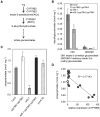
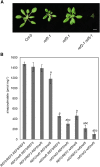
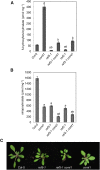
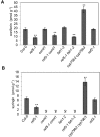
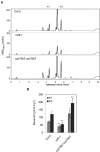
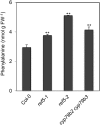
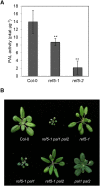


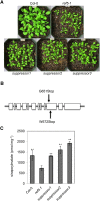

Comment in
-
Metabolic Crosstalk: Interactions between the Phenylpropanoid and Glucosinolate Pathways in Arabidopsis.Plant Cell. 2015 May;27(5):1367. doi: 10.1105/tpc.15.00360. Epub 2015 May 8. Plant Cell. 2015. PMID: 25957387 Free PMC article. No abstract available.
Similar articles
-
Controlled indole-3-acetaldoxime production through ethanol-induced expression of CYP79B2.Planta. 2009 May;229(6):1209-17. doi: 10.1007/s00425-009-0907-5. Epub 2009 Mar 5. Planta. 2009. PMID: 19263076
-
DOF transcription factor AtDof1.1 (OBP2) is part of a regulatory network controlling glucosinolate biosynthesis in Arabidopsis.Plant J. 2006 Jul;47(1):10-24. doi: 10.1111/j.1365-313X.2006.02767.x. Epub 2006 Jun 1. Plant J. 2006. PMID: 16740150
-
Altered methionine metabolism impacts phenylpropanoid production and plant development in Arabidopsis thaliana.Plant J. 2023 Oct;116(1):187-200. doi: 10.1111/tpj.16370. Epub 2023 Jul 4. Plant J. 2023. PMID: 37366635 Free PMC article.
-
Current aspects of auxin biosynthesis in plants.Biosci Biotechnol Biochem. 2016;80(1):34-42. doi: 10.1080/09168451.2015.1086259. Epub 2015 Sep 12. Biosci Biotechnol Biochem. 2016. PMID: 26364770 Review.
-
A Comprehensive Gene Inventory for Glucosinolate Biosynthetic Pathway in Arabidopsis thaliana.J Agric Food Chem. 2020 Jul 15;68(28):7281-7297. doi: 10.1021/acs.jafc.0c01916. Epub 2020 Jul 1. J Agric Food Chem. 2020. PMID: 32551569 Review.
Cited by
-
Completion of the cytosolic post-chorismate phenylalanine biosynthetic pathway in plants.Nat Commun. 2019 Jan 3;10(1):15. doi: 10.1038/s41467-018-07969-2. Nat Commun. 2019. PMID: 30604768 Free PMC article.
-
The ease and complexity of identifying and using specialized metabolites for crop engineering.Emerg Top Life Sci. 2022 Apr 15;6(2):153-162. doi: 10.1042/ETLS20210248. Emerg Top Life Sci. 2022. PMID: 35302160 Free PMC article. Review.
-
Dynamic metabolic and transcriptomic profiling of methyl jasmonate-treated hairy roots reveals synthetic characters and regulators of lignan biosynthesis in Isatis indigotica Fort.Plant Biotechnol J. 2016 Dec;14(12):2217-2227. doi: 10.1111/pbi.12576. Epub 2016 Jun 23. Plant Biotechnol J. 2016. PMID: 27155368 Free PMC article.
-
The Acetate Pathway Supports Flavonoid and Lipid Biosynthesis in Arabidopsis.Plant Physiol. 2020 Feb;182(2):857-869. doi: 10.1104/pp.19.00683. Epub 2019 Nov 12. Plant Physiol. 2020. PMID: 31719153 Free PMC article.
-
Comparative Plant Transcriptome Profiling of Arabidopsis thaliana Col-0 and Camelina sativa var. Celine Infested with Myzus persicae Aphids Acquiring Circulative and Noncirculative Viruses Reveals Virus- and Plant-Specific Alterations Relevant to Aphid Feeding Behavior and Transmission.Microbiol Spectr. 2022 Aug 31;10(4):e0013622. doi: 10.1128/spectrum.00136-22. Epub 2022 Jul 20. Microbiol Spectr. 2022. PMID: 35856906 Free PMC article.
References
-
- Bonawitz N.D., Chapple C. (2010). The genetics of lignin biosynthesis: connecting genotype to phenotype. Annu. Rev. Genet. 44: 337–363. - PubMed
-
- Bonawitz N.D., Soltau W.L., Blatchley M.R., Powers B.L., Hurlock A.K., Seals L.A., Weng J.-K., Stout J., Chapple C. (2012). REF4 and RFR1, subunits of the transcriptional coregulatory complex mediator, are required for phenylpropanoid homeostasis in Arabidopsis. J. Biol. Chem. 287: 5434–5445. - PMC - PubMed
Publication types
MeSH terms
Substances
LinkOut - more resources
Full Text Sources
Other Literature Sources
Molecular Biology Databases

